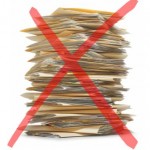 I have to admit, filing is not one of my strongest suits. However, after attending several workshops I was able to set up a filing system that helps me to find what I need, when I need it, fast!
I have to admit, filing is not one of my strongest suits. However, after attending several workshops I was able to set up a filing system that helps me to find what I need, when I need it, fast!
Before I could start the system I had to figure out what I wanted to keep and here are some questions that helped me decide:
- Is it something I need to take action on?
- If I ever need this info again, is it easy to find? (Online or library)
- Is the info still relevant or will it be in in the near future?
- Depending on the answer, the papers will be trashed!
|
The papers that I want to keep, will be divided into:
- Things to act on
- Now (f.e. reply to customer)
- Later (f.e. quarterly bill)
- Things to file for
- Quick access (daily or weekly use, f.e. client files)
- Reference (papers I’m done using but can’t throw away yet, f.e. tax or legal documents)
|
You can subdivide the stacks further into:
- Act on
- File for
- Quick access
- ABC client file
- 123 project, etc.
- Reference
- 2009 Tax files
- Insurance policies, etc.
|
General filing tips:
- Determine where you want your daily, weekly/monthly or reference files. Your daily files should be within easy reach, hopefully in or on your desk. The weekly/monthly files could be in a credenza or filing cabinet and your reference files could even be in another room or the basement.
- Figure out if an alphabetical, numerical or subject filing system will work best for you.
- Label your files in the most obvious way that makes sense to you and would answer the question: how would I search if I needed this file? Automobile or Car? Tip: Best tool to print individual lables is a small label printer.
- Purchase file folders to set up your system. Some people prefer a color coded system but for others (like me) the color doesn’t make a difference. Keep it simple for yourself!
- Insert no more than 10 sheets of paper in a manilla folder, otherwise it will get too bulky soon, making it more difficult to search through your files. To prevent bulky files, you will have to review them regularly (quarterly, annually, etc.) and weed out old stuff.
|
 Now you have your filing system, but wait, you are not done yet!
Now you have your filing system, but wait, you are not done yet!
How will you find your papers quickly when you need them? Ah!
Guess what? There is a system for that too: Index your files! You can buy special indexing software, but you can also create your own index on the computer, using a spreadsheet, database or even wordprocessing software. It is a little bit tedious work when you first set it up, but after the initial work you will only have to update the index when adding and removing papers to your files. You can always hire a VA if you don’t want to deal with this.
The reason why it should be on the computer is for quick retrieval of the files. You can do a search for your files faster in f.e. Excel than going through a rolodex system.
So how do you set up your index?
This is where your labeling system comes in!
- Create a list of your storage locations, categories, file names, keywords (for searches), and year.
- Add these to a spreadsheet or table.
- Save your index file.
- Update whenever you add or remove papers to your files.
|
Next time you need to retrieve that 2007 tax file, you will know exactly where to find it!
 I have to admit, filing is not one of my strongest suits. However, after attending several workshops I was able to set up a filing system that helps me to find what I need, when I need it, fast!
I have to admit, filing is not one of my strongest suits. However, after attending several workshops I was able to set up a filing system that helps me to find what I need, when I need it, fast! Now you have your filing system, but wait, you are not done yet!
Now you have your filing system, but wait, you are not done yet!
Thanks for the post, I can use these tips to organize my files!
Comments are closed.